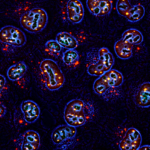Lien vers Pubmed [PMID] – 15359282
EMBO J. 2004 Oct;23(19):3844-53
Sumoylation represents a conserved mechanism of post-translational protein modification. We report that Pli1p, the unique fission yeast member of the SP-RING family, is a SUMO E3 ligase in vivo and in vitro. pli1Delta cells display no obvious mitotic growth defects, but are sensitive to the microtubule-destabilizing drug TBZ and exhibit enhanced minichromosome loss. The weakened centromeric function of pli1Delta cells may be related to the defective heterochromatin structure at the central core, as shown by the reduced silencing of an ura4 variegation reporter gene inserted at cnt and imr. Interestingly, pli1Delta cells also exhibit enhanced loss of the ura4 reporter at these loci, likely by gene conversion using homologous sequences as information donors. Moreover, pli1Delta cells exhibit consistent telomere length increase, possibly achieved by a similar process. Point mutations within the RING finger of Pli1p totally or partially reproduce the pli1 deletion phenotypes, thus correlating with their sumoylation activity. Altogether, these results strongly suggest that Pli1p, and by extension sumoylation, is involved in mechanisms that regulate recombination in particular heterochromatic repeated sequences.



